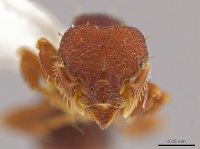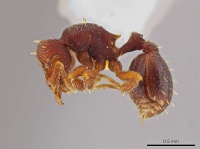Octostruma megabalzani
| Octostruma megabalzani | |
|---|---|

| |
| Scientific classification | |
| Kingdom: | Animalia |
| Phylum: | Arthropoda |
| Class: | Insecta |
| Order: | Hymenoptera |
| Family: | Formicidae |
| Subfamily: | Myrmicinae |
| Tribe: | Attini |
| Genus: | Octostruma |
| Species: | O. megabalzani |
| Binomial name | |
| Octostruma megabalzani Longino, 2013 | |
Octostruma megabalzani is a montane species. The lowest elevation record is 950 m in Panama, and the highest record is 2000 m in southern Peru. It has been collected most often in mature cloud forest and montane oak forest habitats, but has also been collected in litter beneath cultivated coffee. All collections are from Berlese and Winkler samples of sifted litter and rotten wood from the forest floor. (Longino 2013)
Identification
Differing from Octostruma balzani as follows (O. balzani characters in parentheses): petiole with a pair of erect setae (typically lacking); postpetiole with 2–4 erect setae (0–2); first gastral tergite with 16–22 erect setae, more or less evenly distributed on tergite, gastral setae stiff, flattened, but nearly linear, very weakly clavate (first gastral tergite with 4–16 erect setae, these clustered posteriorly, relatively more broadened apically); color dark brown (red brown); HW 0.61–0.66 (HW 0.50–0.63). (Longino 2013)
Keys including this Species
Distribution
Latitudinal Distribution Pattern
Latitudinal Range: 8.833° to -17.38685°.
| North Temperate |
North Subtropical |
Tropical | South Subtropical |
South Temperate |
- Source: AntMaps
Distribution based on Regional Taxon Lists
Neotropical Region: Bolivia, Panama (type locality), Peru.
Distribution based on AntMaps
Distribution based on AntWeb specimens
Check data from AntWeb
Countries Occupied
| Number of countries occupied by this species based on AntWiki Regional Taxon Lists. In general, fewer countries occupied indicates a narrower range, while more countries indicates a more widespread species. |

|
Estimated Abundance
| Relative abundance based on number of AntMaps records per species (this species within the purple bar). Fewer records (to the left) indicates a less abundant/encountered species while more records (to the right) indicates more abundant/encountered species. |

|
Biology
The Andean and Central American specimens of O. megabalzani appear identical. Both occur in elevational parapatry with lowland Octostruma balzani. Whether the Andean and Central American populations are members of one montane clade or convergently evolved montane forms is an open question.
|
Castes
Nomenclature
The following information is derived from Barry Bolton's Online Catalogue of the Ants of the World.
- megabalzani. Octostruma megabalzani Longino, 2013: 42, figs. 1E, 3D, 5B, 9B, 31, 42 (w.q.) PANAMA.
Unless otherwise noted the text for the remainder of this section is reported from the publication that includes the original description.
Description
Worker
HW 0.61–0.66, HL 0.56–0.61, WL 0.60–0.66, CI 107–111 (n=7). Similar in most respects to Octostruma balzani except for the characters in the diagnosis (see the identification section above).
Queen
HW 0.67, HL 0.62, WL 0.84, CI 108 (n=1). Labrum, mandible, scape, antennal scrobe, and head sculpture similar to worker; face with 8 erect setae distributed symmetrically around lateral and posterior margins of head, a seta on low ridge in front of each compound eye, 6 setae across vertex between compound eyes; ocelli distinct; compound eye large, multifaceted, about 12 ommatidia in longest row.
Mesosoma with queen-typical alar sclerites; sculpture like workers; anepisternum and katepisternum separated by strong sulcus; posterodorsal propodeum concave; propodeal spines pronounced, in the form of flattened perpendicular plates, acute in profile; pronotum with 4 erect setae, mesoscutum with 10, axilla with 1, scutellum with 2, metanotum with 2, petiolar node with 2, postpetiole and gaster missing from single queen available for examination. Other characters similar to worker.
Type Material
Holotype worker: Panama, Chiriquí: 24 km W El Hato del Volcan [8.833, -82.754, ±10 km], 1160 m, 26 Jun 1976, cloud forest, ex sifted leaf litter (A. F. Newton) Museum of Comparative Zoology, unique specimen identifier MCZ-ENT00511006]. Paratype queen, worker: same data MCZ, MCZ-ENT00511004; National Museum of Natural History, MCZ-ENT00511005.
References
- Longino, J.T. 2013. A revision of the ant genus Octostruma Forel 1912 (Hymenoptera, Formicidae). Zootaxa 3699, 1-61. doi:10.11646/zootaxa.3699.1.1


